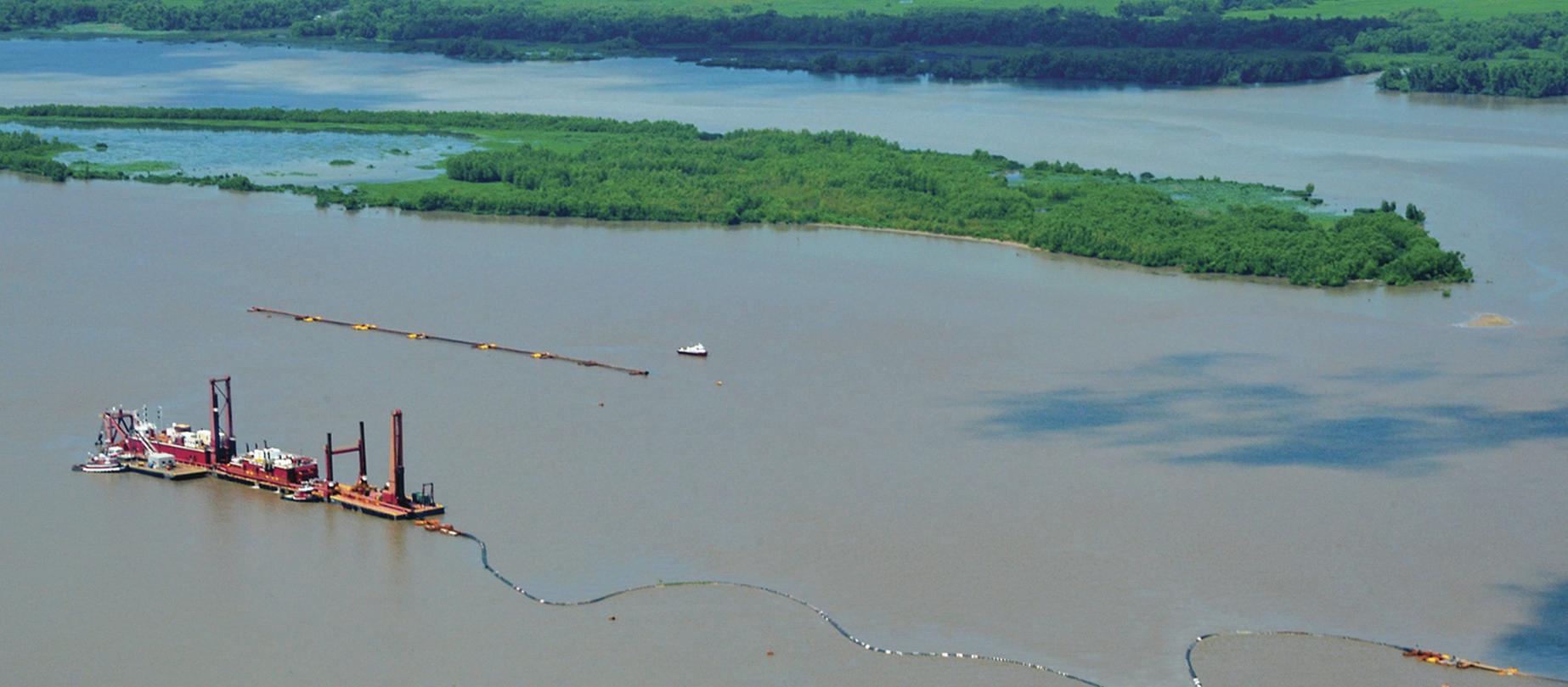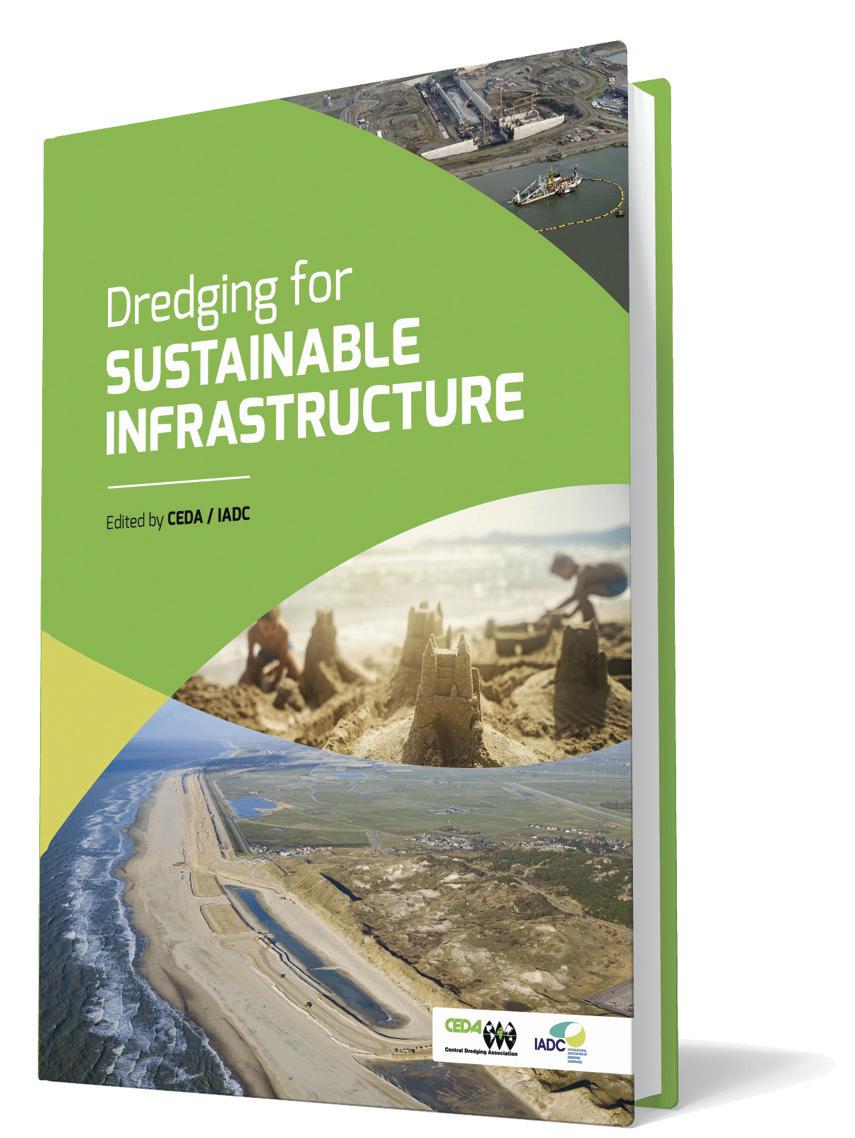
7 minute read
FEATURES
DREDGING TOWARDS SUSTAINABILITY
An increasing amount of attention is being given to the concept of sustainability and dredging has been evolving to keep up, writes René Kolman, Secretary General of the IADC
A dredger is a tool. For hundreds of years, this tool has been used to shape and manipulate the interface between land and water in order to support a variety of human activities, including navigation, coastal protection and flood risk management, as well as residential, commercial, agricultural and hydro-power development. The use of dredging to achieve these purposes has always been guided by an understanding of the costs and benefits of applying the tool.
However, in the last several decades, the understanding of what constitutes costs and benefits has evolved substantially beyond the direct monetary costs of using the tool and the direct monetary benefits of what the tool was used to create. Over the last 50 years, the cost-benefit evolution was aided by the environmental movement.
Dredging makes the implementation of marine infrastructure possible. Whether the infrastructure is for port development, flood protection measures, reclamations or windfarms, dredging is a tool which manipulates the physical structure of the environment to produce a function that nature didn't create on its own. The activity has been and will be essential for global development and prosperity into the future.
THE GROWING FOCUS ON SUSTAINABILITY
An increasing amount of attention is being given to the concept of sustainability as an approach to informing social, environmental and economic development.
In 2015, the United Nations released its Sustainable Development Goals (SDGs) as a part of its 2030 Agenda for Sustainable Development. A total of 17 goals were established and encompass a very broad range interests, values and objectives.
As a means for developing water resources infrastructure, dredging and its relationship to each of the SDGs varies from weakly to strongly connected. For example, the use of dredging to construct efficient and productive navigation infrastructure is directly connected to SDGs 2, 7, 8, 9, 10, 11, 12, 13, 15 and 16. As a tool used to provide coastal protection and infrastructure
8 René is Secretary General of the IADC

supporting flood risk management, dredging clearly supports SDGs 1, 3, 7, 10, 12 and 14, among others.
The dredging and water infrastructure community is working towards incorporating these goals into the infrastructure development process and effectively communicating how such projects support the SDGs.
Over the past ten to 15 years, the international dredging community has embraced a different kind of thinking, looking beyond the scope of isolated dredging activities towards a wider
Over the past ten to 15 years, the international dredging community has embraced a different kind of thinking, looking beyond the scope of isolated dredging activities towards a wider context. - Réne Kolman
context. Water infrastructure development projects are viewed as an opportunity to add value to the natural and socio-economic systems, finding opportunities to cooperate and collaborate with natural processes. This approach adapts ports to coastal ecosystems, ships to rivers and local communities to cycles of low and high water.
Dredging is but one component of an infrastructure project. Any one piece of infrastructure functions as a part of a larger network of infrastructure as well as the surrounding ecosystem. The word infrastructure is used to refer to the diverse range of structures, features and capabilities that are developed through the use of dredging such as navigation channels and waterways, ports and harbours, levees and dykes, as well as nature-based infrastructure such as beaches and dunes, islands, wetlands and many other forms of habitat.
IADC promotes sustainable activities among the dredging industry and the public, presenting radically different methods to address the increasing climate pressures on low-lying deltas as
8 The Sustainable
Development Goals (SDGs) are a collection of 17 global goals set by the UN
Photo: Wings of Anglers
well as modern-day society's incredibly strong demands on the sustainability of water infrastructure projects. Through its joint publication with the Central Dredging Association, Dredging for Sustainable Infrastructure, guidance is made available to project owners, regulators, consultants, designers and contractors.
This publication represents a significant milestone in the ongoing journey towards sustainability but continuous advancements to the approach are taking place within the dredging industry. A next step for sustainable projects is the inclusion of externalities - the non-tangible costs and benefits - in the review of project proposals. In fact, an extension of the ecosystem services concept.
For marine contractors, stakeholder value is created and/or reduced via the impacts - externalities - of marine infrastructure projects. They can generate both positive or negative outcomes. In addition to environmental externalities such as ecosystem services, stakeholder value within the marine environment is related to social externalities such as health and safety, and economic externalities such as job creation. These values can be expressed in monetary terms and included in the overall stakeholder value, highlighting the relevance of taking a wider scope of stakeholder value into account. Project teams must adopt new ways of thinking, acting and interacting.
CASE STUDY: HORSESHOE BEND DREDGING ON THE ATCHAFALAYA RIVER, LOUISIANA, UNITED STATES
In 1999, options for managing dredging material from the navigation channel near Horseshoe Bend on the Atchafalaya River near the Gulf Coast of Louisiana, USA were nearly exhausted. Sites for additional wetland creation or upland disposal along the banks of the river were limited. Operations managers and engineers with the USACE decided to use strategic sediment placement as a means of managing the dredged material by placing the sediment - via cutter dredger pipeline - in the middle of the river just upstream of a natural shoal.
Project engineers expected the placed sediments to be moved by the river to the natural shoal and that these strategically placed sediments would contribute to the formation of an island habitat at the location of the shoal. Beginning in 2002, between 0.4 and 1.4 million cubic meters of sediment were placed in this manner every one to three years, as determined by the schedule of maintenance dredging. Over the following dozen years, this change in operational practice resulted in the formation of a 35- hectare island that includes a diverse combination of habitats and ecosystem services. The USACE Engineering with Nature programme has supported studies including ecological surveys

that have documented the rich species diversity and ecological functions such as nutrient cycling and carbon sequestration provided by the island. In addition, these surveys have revealed evidence that the island is being used for recreational purposes thus providing social benefits to the local population. Strategic placement of the dredged material in the river also avoids the need for transporting the material to the open bay for disposal, which would result in much greater fuel usage and emissions including carbon dioxide.
In addition to the broad range of environmental benefits associated with the island, the project is also producing practical engineering and economic benefits. As a result of the island's formation, the navigation channel shifted its position in the river from the west to the east side of the river, due to hydrologic influence of the island on the flow of the river. This 'naturally' realigned channel provides a better, safer transit path around Horseshoe Bend for commercial navigation. The realigned channel has also required less dredging due to more efficient hydraulics and sediment transport in the channel. The USACE estimates that more than US$1 million has been saved over the last ten years in reduced maintenance dredging at Horseshoe Bend.

THE PUBLICATION
CEDA and the IADC's new publication is a guide on delivering dredging projects that enhance the natural and socioeconomic systems and is an invaluable resource for those responsible for delivering projects with longevity which need to do more than just the basics. Project owners, regulators, consultants, designers and contractors looking for an up-to-date reference should find it to be a useful tool.
The team of expert authors represents international institutes, dredging contractors, consultants and project owners. Edited and published by CEDA and IADC, Dredging for Sustainable Infrastructure is available in a print and e-book edition. A course
https://dfsi-course-0620-nl.iadc
events.com/ will be held on the subject from 1-2 December 2020 in The Hague, Netherlands.
8 The river island at
Horseshoe Bend on the lower Atchafalaya River, Louisiana is being self-designed by dredged sediment strategically placed upriver
8 CEDA and the
IADC's new publication Dredging for Sustainable Infrastructure
Photo: IADC










